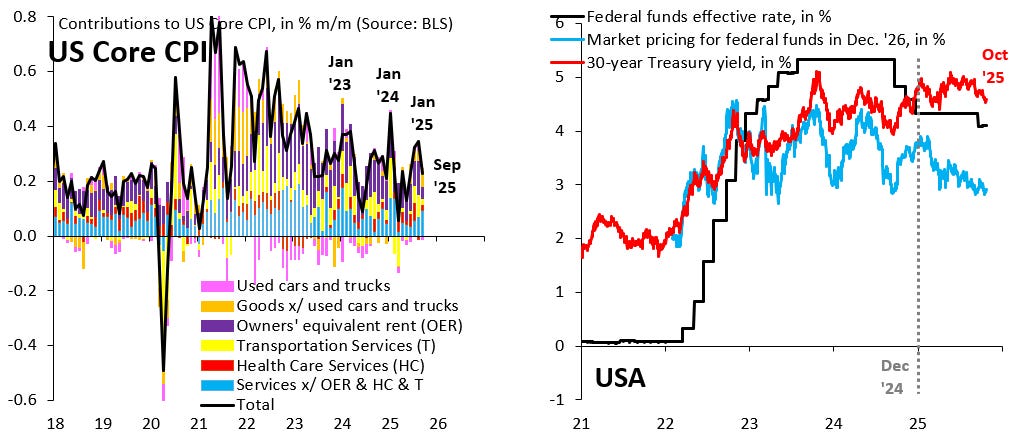- The Sky Today on Sunday, October 26: Iapetus at inferior conjunction Astronomy Magazine
- This Week’s Sky at a Glance, October 24 –November 2 Sky & Telescope
- See a razor-thin crescent moon line up with Mars and Mercury at sunset on Oct. 23 Space
Blog
-
The Sky Today on Sunday, October 26: Iapetus at inferior conjunction – Astronomy Magazine
-

Where next for markets after the gold rush
Gold prices rallied hard amid the chaos of the reciprocal tariff roll-out in early April. Once that episode was over, they went into a holding pattern and stayed there until Chair Powell’s dovish speech at Jackson Hole on August 22, which unleashed a true frenzy of precious metals buying. The IMF/WB annual meetings burst that bubble and precious metals prices have gone back into the same holding pattern they went into once the April tariff shock had worn off. However, my sense is that the underlying drivers of the “debasement trade” are only getting stronger, so that will keep going.
In today’s post, I lay out how markets might evolve now that the “gold rush” of recent months has ended. Needless to say, forecasting is a dangerous business and I’ll likely be wrong on many fronts. But I feel strongly that the “debasement trade” is here to stay and will only build over the medium term. If that is true, the question then becomes where this trade will pop up next. Will it again be in precious metals, in longer-term yields, in equities or in currencies? I discuss all this in today’s post.
-
Why the “debasement trade” will build: the Fed is cutting as underlying inflation rises. The “debasement trade” is about the fear that central banks will bend to the will of politicians and monetize unsustainable government debt levels. Some of this “fiscal dominance” is already playing out in the US. The left chart below shows the drivers of monthly core CPI inflation (black line). My preferred measure of underlying inflation – what inflation is after you filter out all the noise – is the blue bars, which have trended up for half a year. That just isn’t an environment where the Fed should be cutting, let alone be in a substantial easing cycle. The blue line in the right chart below shows that markets price almost five 25 basis point rate cuts between now and the end of 2026. The fact that the Fed isn’t pushing back on this market pricing understandably raises questions about its credibility and is one reason why longer-term Treasury yields (the red line in the right chart below) remain high even as more and more Fed cuts get priced.
-
Why the “debasement trade” will build: fewer safe haven assets. I’ve been banging on about how safe haven countries like Japan or Germany are losing that status. Indeed, there are many places across the G10 where fiscal policy is unsustainable, not just in the US. This is why the Dollar was stable in the course of the precious metals rally in recent months, as the blue line in the left chart below shows. The debasement trade isn’t about the US, it’s about a much broader loss of confidence in fiat currencies. The Japanese Yen would have been a key place to hide in the past, but the blue line in the right chart below shows that’s tumbling against the Dollar. The safe havens of today are Switzerland (black line), Sweden (red line) and Norway (orange line). Unsurprisingly, these are places where government debt is low because fiscal policy hasn’t become unmoored.

-
Where will the “debasement trade” pop up next? Precious metals are back in the same holding pattern they were in after the April tariff shock wore off. Longer-term bond yields are in a similar holding pattern as markets price more and more rate cuts for G10 central banks, which is pulling long-end yields down for now. Perhaps the best “debasement trade” currently is the S&P 500, which is up over 15 percent so far this year. President Trump frequently looks to the stock market as validation of his policies. The S&P 500 won’t be allowed to fall. What will also not fall is the Dollar, which – as the left chart below shows – has been stable since its sharp fall in April. So much “bad news” is priced into rate differentials, which have moved massively against the Dollar, that the only way for the greenback is up. Indeed, over the past few weeks, I’ve heard more and more talk of a return of “US exceptionalism.” Sentiment on the Dollar is changing for the better.

Continue Reading
-
-

Eurogamer Weekly Digest, 26th October – highlights you might have missed this week in features, reviews, and news
And here we are again; seven days older, seven days wiser, and if you were silly enough to watch that VHS tape, seven days to die. That means we’re back with another Weekly Digest – in which we recap some of the highlights…
Continue Reading
-
The world’s fourth-largest mobile giant is coming to Israel
The world’s fourth-largest mobile giant is coming to Israel | The Jerusalem Post Continue Reading
-

the man who collected the world
Patrycja Boryka and
Paul Johnson,East Yorkshire & Lincolnshire
 Getty Images
Getty ImagesA replica of HMB Endeavour in Sydney, Australia He made his name on a voyage around the world alongside Captain James Cook, before becoming a friend of King George III and…
Continue Reading
-

Jupiter Enabled Solar System’s Unique Inner Architecture, Says Study
Illustration comparing the planets of the Solar System and the Sun on the same scale. The planets are shown to scale relative to each other but their distances are not. From left to right the bodies are: the Sun, Mercury, Venus, Earth, Mars,…
Continue Reading
-

The First Interstellar Car in NASCAR’s History | by Avi Loeb | Oct, 2025
Press enter or click to view image in full sizeAlex Malycke’s car at the NASCAR race in Bakersfield, California on October 25, 2025. (Image credit: Loeb’s photo collection) On October 25, 2025, I attended the NASCAR car race in Bakersfield,…
Continue Reading
-

The Hard-Luck Case For AGI And AI Superintelligence As An Extinction-Level Event
Realizing that the advent of AGI and ASI could trigger a dire AI-driven extinction-level event that wipes us all out.
getty
In today’s column, I examine the widely debated and quite distressing contention that once we attain artificial general…
Continue Reading
-

Secretary-General of ASEAN has a pull-aside meeting with FIFA President
ASEAN shall develop friendly relations and mutually beneficial dialogues, cooperation and partnerships with countries and sub-regional, regional and international organisations and institutions. This includes external partners, ASEAN…
Continue Reading
-

Assessing Valuation Following Recent Share Price Gains
Kirin Holdings Company (TSE:2503) shares have edged higher over the past month, drawing attention from investors interested in the food and beverage sector. The stock’s upward trend raises questions about what is driving recent sentiment.
See our latest analysis for Kirin Holdings Company.
Kirin’s share price has climbed 11.3% over the past three months, reflecting a wave of renewed optimism about its growth outlook, while the total shareholder return over the past year sits at 1.5%. Investors watching this steady uptrend may be sensing improving fundamentals and a potential rerating on valuation, especially as the sector sees pockets of positive momentum.
If you’re looking to broaden your search for fresh opportunities, consider exploring fast growing stocks with strong insider ownership. fast growing stocks with high insider ownership
The question now is whether Kirin’s recent rally still offers attractive value for new investors, or if the market has already factored in the company’s potential for future growth. Is there a buying opportunity left?
Kirin Holdings trades at a price-to-earnings ratio of 33.4 times, which is notably higher than both its industry average and the fair multiple suggested by valuation models. The current share price of ¥2,221.5 puts this premium in focus.
The price-to-earnings (P/E) ratio measures how much investors are willing to pay for each unit of the company’s earnings. For an established food and beverage group like Kirin, this number reflects market expectations for profit stability, future growth, and sector competitiveness. However, such a high P/E raises the question of whether recent optimism is running ahead of underlying performance.
Compared to the Asian Beverage industry average of 19.6x, Kirin’s stock is expensive. It also exceeds the company’s own estimated fair P/E of 30.5x, suggesting the stock could be priced for stronger growth or efficiency gains than currently forecast. If expectations reset, the market could drive the multiple closer to this fair ratio in the future.
Explore the SWS fair ratio for Kirin Holdings Company
Result: Price-to-Earnings of 33.4x (OVERVALUED)
However, slower revenue growth or shifts in market sentiment could quickly cool enthusiasm and put downward pressure on Kirin’s current valuation premium.
Find out about the key risks to this Kirin Holdings Company narrative.
While Kirin looks expensive based on its price-to-earnings ratio, the SWS DCF model offers a very different takeaway. According to this approach, the stock is trading at a steep 60% discount to its estimated fair value of ¥5,552.77. This suggests that, even after its recent run, the market may be overlooking longer-term cash flow potential. Could investors be underestimating Kirin’s future growth, or is there something the DCF is not capturing?
Continue Reading